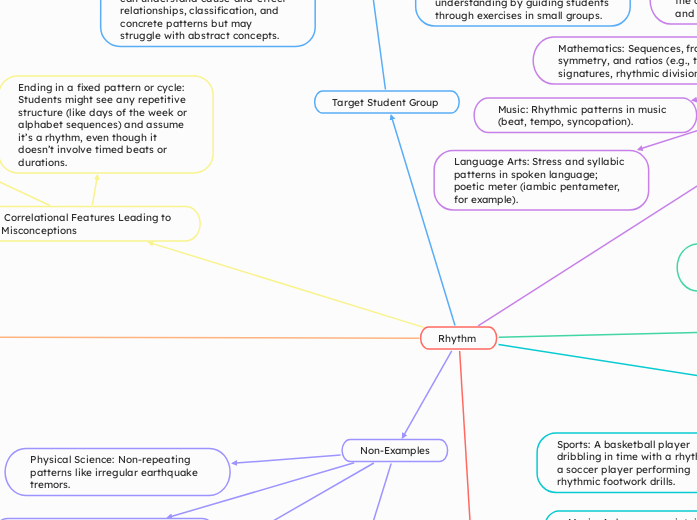Rhythm
Prototypes
Music: A steady 4/4 drumbeat.
Sports: The rhythmic pattern in a series of synchronized swimming movements.
Sports: The rhythmic pattern in a series of synchronized swimming movements.
Physical Science: A pendulum swinging back and forth, demonstrating periodic motion.
Relevance to Other Disciplines
Music: Rhythmic patterns in music (beat, tempo, syncopation).
Mathematics: Sequences, fractions, symmetry, and ratios (e.g., time signatures, rhythmic divisions).
Physical Science: Understanding the concept of waves (vibrations and oscillations) and frequency.
Language Arts: Stress and syllabic patterns in spoken language; poetic meter (iambic pentameter, for example).
Health: Exercise and movement (understanding how rhythmic exercises help with coordination and physical fitness).
Sports: Rhythm in sports, such as timing in synchronized movements or team sports (football, basketball).
Non-Examples
Music: A random series of chaotic sounds with no clear beat.
Sports: A player moving erratically with no timing or rhythm in their actions (e.g., an unpredictable series of movements in basketball or soccer).
Language Arts: Prose with irregular phrasing and no set rhythm or meter (such as free verse poetry or regular spoken dialogue).
Physical Science: Non-repeating patterns like irregular earthquake tremors.
Target Student Group
10-12 years old
Physical: Children are developing better coordination and muscle control, making them able to explore more physical manifestations of rhythm (e.g., through dance or sports).
Social: Students are forming stronger peer connections and may collaborate on rhythmic activities in groups, such as creating music or performing skits.
Emotional: Students may feel a sense of belonging or pride when able to master rhythmic patterns, enhancing self-esteem.
Academic: Cognitive abilities are developing in terms of abstract thinking, allowing for connections between rhythm and various subject areas (music, math, language, physical science).
Attention Span: Expect a moderate to short attention span (10-15 minutes for active engagement activities), with breaks for movement or group work.
Piagetian Development: Students are typically in the Concrete Operational Stage, meaning they can understand cause-and-effect relationships, classification, and concrete patterns but may struggle with abstract concepts.
Vygotskian Considerations: Collaborative work (scaffolding) could be used to support understanding by guiding students through exercises in small groups.
Exemplars
Obvious Exemplars
Music: A drummer maintaining a steady beat on a snare drum.
Sports: A basketball player dribbling in time with a rhythm, or a soccer player performing rhythmic footwork drills.
Language Arts: "Twinkle Twinkle Little Star," which has a rhythmic pattern of stressed and unstressed syllables.
Atypical Exemplars
Math: Patterns in multiplication tables (e.g., skip counting).
Physical Science: Waves in the ocean that follow a rhythmic pattern of crests and troughs.
Defining Features/Characteristics of the Concept:
Regularity/Pattern: A repeating series of movements or sounds that occur at consistent intervals.
Timing/Duration: The measurement of intervals, whether short or long, in a rhythmic sequence.
Beat/Tempo: A steady pulse or rhythm that sets the foundation for patterns in music, sports, and other activities.
Syncopation: Shifting accents or stresses away from the normal beat pattern.
Flow and Continuity: How rhythm creates a sense of fluidity or connection between elements.
Dynamism: Changes in volume, speed, or intensity, contributing to variety and excitement in rhythms.
Misconceptions
Subtopic
"Anything that has a pattern or sequence is a rhythm."
Students may overgeneralize and include things like alphabetical order or random number sequences as rhythm when they lack the consistent regularity or temporal aspect.
Under-generalizing
"Rhythm only applies to music."
Students might believe rhythm is exclusive to musical activities, overlooking its relevance in daily life
Correlational Features Leading to Misconceptions
Ending in a fixed pattern or cycle: Students might see any repetitive structure (like days of the week or alphabet sequences) and assume it’s a rhythm, even though it doesn’t involve timed beats or durations.
Word stress: Students may incorrectly apply rhythmic principles (like stress patterns) to all words, leading to confusion when encountering irregularly stressed words.
Visual patterns: Students might mistakenly assume that rhythmic patterns can always be visually perceived, even when rhythm often involves auditory or kinetic elements that can’t be seen but are felt or heard.
